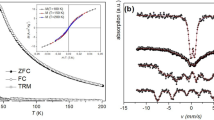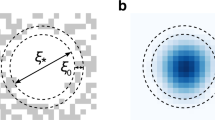Abstract
Memory and rejuvenation effects in the magnetic response of off-equilibrium spin glasses have been widely regarded as the doorway into the experimental exploration of ultrametricity and temperature chaos. Unfortunately, despite more than twenty years of theoretical efforts following the experimental discovery of memory and rejuvenation, these effects have, thus far, been impossible to reliably simulate. Yet, three recent developments convinced us to accept this challenge: first, the custom-built Janus II supercomputer makes it possible to carry out simulations in which the very same quantities that can be measured in single crystals of CuMn are computed from the simulation, allowing for a parallel analysis of the simulation and experimental data. Second, Janus II simulations have taught us how numerical and experimental length scales should be compared. Third, we have recently understood how temperature chaos materializes in aging dynamics. All these three aspects have proved crucial for reliably reproducing rejuvenation and memory effects on the computer. Our analysis shows that at least three different length scales play a key role in aging dynamics, whereas essentially all the theoretical analyses of the aging dynamics emphasize the presence and crucial role of a single glassy correlation length.
This is a preview of subscription content, access via your institution
Access options
Access Nature and 54 other Nature Portfolio journals
Get Nature+, our best-value online-access subscription
$29.99 / 30 days
cancel any time
Subscribe to this journal
Receive 12 print issues and online access
$209.00 per year
only $17.42 per issue
Buy this article
- Purchase on Springer Link
- Instant access to full article PDF
Prices may be subject to local taxes which are calculated during checkout




Similar content being viewed by others
Data availability
The data contained in the figures of this paper, accompanied by the gnuplot script files that generate these figures, are publicly available via GitHub at https://github.com/janusII/Rejuvenation_memory.git. The data that support the findings of this study are available from the corresponding author upon reasonable request.
Code availability
The codes that support the findings of this study are available from the corresponding author upon reasonable request
Change history
23 May 2023
In the version of this article initially published, call outs to panels in Figure 3, now referring to “left” or “right,” appeared originally as “top” and “bottom”; the callouts have been updated in the HTML and PDF versions of the article.
References
Struik, C. L. E. Physical Aging in Amorphous Polymers and Other Materials (Elsevier, 1980).
Jonason, K., Vincent, E., Hammann, J., Bouchaud, J. P. & Nordblad, P. Memory and chaos effects in spin glasses. Phys. Rev. Lett. 81, 3243–3246 (1998).
Lundgren, L., Svedlindh, P. & Beckman, O. Anomalous time dependence of the susceptibility in a Cu(Mn) spin glass. J. Magn. Magn. Mater. 31–34, 1349–1350 (1983).
Jonsson, T., Jonason, K., Jönsson, P. E. & Nordblad, P. Nonequilibrium dynamics in a three-dimensional spin glass. Phys. Rev. B 59, 8770 (1999).
Hammann, J. et al. Comparative review of aging properties in spin glasses and other disordered materials. J. Phys. Soc. Jpn Supplement A, 206–211 (2000).
Mydosh, J. A. Spin Glasses: An Experimental Introduction (Taylor and Francis, 1993).
Zhai, Q., Martin-Mayor, V., Schlagel, D. L., Kenning, G. G. & Orbach, R. L. Slowing down of spin glass correlation length growth: simulations meet experiments. Phys. Rev. B 100, 094202 (2019).
Zhai, Q., Orbach, R. L. & Schlagel, D. L. Evidence for temperature chaos in spin glasses. Phys. Rev. B 105, 014434 (2022).
Zhai, Q. et al. Scaling law describes the spin-glass response in theory, experiments, and simulations. Phys. Rev. Lett. 125, 237202 (2020).
Paga, I. et al. Spin-glass dynamics in the presence of a magnetic field: exploration of microscopic properties. J. Stat. Mech. 2021, 033301 (2021).
Albert, S. et al. Fifth-order susceptibility unveils growth of thermodynamic amorphous order in glass-formers. Science 352, 1308–1311 (2016).
Mézard, M., Parisi, G. & Virasoro, M. Spin-Glass Theory and Beyond (World Scientific, 1987).
Vincent, E., Hammann, J., Ocio, M., Bouchaud, J.-P. & Cugliandolo, L. F. Slow dynamics and aging in spin glasses in complex behavior of glassy systems (eds Rubí, M. & Pérez-Vicente, C.) 492 (Springer, 1997).
Djurberg, C., Jonason, K. & Nordblad, P. Magnetic relaxation phenomena in a CuMn spin glass. Eur. Phys. J. B 10, 15–21 (1999).
Komori, T., Yoshino, H. & Takayama, H. Numerical study on aging dynamics in the 3D Ising spin-glass model. II. Quasi-equilibrium regime of spin auto-correlation function. J. Phys. Soc. Jpn 69, 1192–1201 (2000).
Picco, M., Ricci-Tersenghi, F. & Ritort, F. Chaotic, memory, and cooling rate effects in spin glasses: evaluation of the Edwards-Anderson model. Phys. Rev. B 63, 174412 (2001).
Berthier, L. & Bouchaud, J.-P. Geometrical aspects of aging and rejuvenation in the Ising spin glass: a numerical study. Phys. Rev. B 66, 054404 (2002).
Takayama, H. & Hukushima, K. Numerical study on aging dynamics in the 3D Ising spin–glass model: III. Cumulative memory and ‘chaos’ effects in the temperature-shift protocol. J. Phys. Soc. Jpn 71, 3003–3010 (2002).
Maiorano, A., Marinari, E. & Ricci-Tersenghi, F. Edwards-Anderson spin glasses undergo simple cumulative aging. Phys. Rev. B 72, 104411 (2005).
Jiménez, S., Martín-Mayor, V. & Pérez-Gaviro, S. Rejuvenation and memory in model spin glasses in three and four dimensions. Phys. Rev. B 72, 054417 (2005).
Edwards, S. F. & Anderson, P. W. Theory of spin glasses. J. Phys. F: Met. Phys. 5, 965 (1975).
Edwards, S. F. & Anderson, P. W. Theory of spin glasses. II. J. Phys. F: Met. Phys. 6, 1927 (1976).
Baity-Jesi, M. et al. Janus II: a new generation application-driven computer for spin-system simulations. Comp. Phys. Comm 185, 550–559 (2014).
Marinari, E., Parisi, G., Ruiz-Lorenzo, J. & Ritort, F. Numerical evidence for spontaneously broken replica symmetry in 3D spin glasses. Phys. Rev. Lett. 76, 843–846 (1996).
Joh, Y. G., Orbach, R., Wood, G. G., Hammann, J. & Vincent, E. Extraction of the spin glass correlation length. Phys. Rev. Lett. 82, 438–441 (1999).
Belletti, F. et al. Nonequilibrium spin-glass dynamics from picoseconds to one tenth of a second. Phys. Rev. Lett. 101, 157201 (2008).
Baity-Jesi, M. et al. Aging rate of spin glasses from simulations matches experiments. Phys. Rev. Lett. 120, 267203 (2018).
Baity-Jesi, M. et al. Matching microscopic and macroscopic responses in glasses. Phys. Rev. Lett. 118, 157202 (2017).
Paga, I. et al. Magnetic-field symmetry breaking in spin glasses. Preprint at https://arxiv.org/abs/2207.10640 (2022).
Cugliandolo, L. F. & Kurchan, J. Mean-field theory of temperature cycling experiments in spin glasses. Phys. Rev. B 60, 922–930 (1999).
Berthier, L. & Bouchaud, J.-P. Comment on ‘symmetrical temperature-chaos effect with positive and negative temperature shifts in a spin glass’. Phys. Rev. Lett 90, 059701 (2003).
McKay, S. R., Berker, A. N. & Kirkpatrick, S. Spin-glass behavior in frustrated Ising models with chaotic renormalization-group trajectories. Phys. Rev. Lett. 48, 767–770 (1982).
Bray, A. J. & Moore, M. A. Chaotic nature of the spin-glass phase. Phys. Rev. Lett. 58, 57–60 (1987).
Kondor, I. On chaos in spin glasses. J. Phys. A: Math. Gen. 22, L163 (1989).
Rizzo, T. & Crisanti, A. Chaos in temperature in the Sherrington-Kirkpatrick model. Phys. Rev. Lett. 90, 137201 (2003).
Parisi, G. & Rizzo, T. Chaos in temperature in diluted mean-field spin-glass. J. Phys. A: Math. Theor. 43, 235003 (2010).
Baity-Jesi, M. et al. Temperature chaos is present in off-equilibrium spin-glass dynamics. Commun. Phys. 4, 74 (2021).
Belletti, F. et al. An in-depth look at the microscopic dynamics of Ising spin glasses at fixed temperature. J. Stat. Phys. 135, 1121–1158 (2009).
Castillo, H. E., Chamon, C., Cugliandolo, L. F. & Kennett, M. P. Heterogeneous aging in spin glasses. Phys. Rev. Lett. 88, 237201 (2002).
Jaubert, L. C., Chamon, C., Cugliandolo, L. F. & Picco, M. Growing dynamical length, scaling, and heterogeneities in the 3D Edwards-Anderson model. J. Stat. Mech. 2007, P05001 (2007).
Berche, P.-E., Chatelain, C., Berche, B. & Janke, W. Bond dilution in the 3D Ising model: a Monte Carlo study. Eur. Phys. J. B 38, 463–474 (2004).
Baity-Jesi, M. et al. Critical parameters of the three-dimensional Ising spin glass. Phys. Rev. B 88, 224416 (2013).
Paga, I. From Glassy Bulk Systems to Spin-Glass Films: Simulations Meet Experiments. PhD thesis (Complutense Univ. of Madrid and University of Rome, La Sapienza, 2021).
Acknowledgements
We acknowledge the valuable contributions and ideas of our collaborator Raffaele Tripiccione. The Janus project would have been impossible without his technical expertise. We thank R. Orbach for discussions. This work was partly supported by grants nos. PID2020-112936GB-I00, PID2019-103939RB-I00, PGC2018-094684-B-C21, PGC2018-094684-B-C22 and PID2021-125506NA-I00 funded by MCIN/AEI/10.13039/501100011033 by “ERDF A way of making Europe” and by the “European Union; and by the Atracción de Talento program (ref. 2019-T1/TIC-12776) funded by Comunidad de Madrid and Universidad Complutense de Madrid (Spain). This project has received funding from the European Research Council under the European Union’s Horizon 2020 research and innovation programme (grant no. 694925; G.P.). We were also partly supported by ICSC – Centro Nazionale di Ricerca in High Performance Computing, Big Data and Quantum Computing, funded by the European Union – NextGenerationEU. I.G.-A.P. was supported by MCIU (Spain) through FPU grant no. FPU18/02665. J.M.-G. was supported by the Ministerio de Universidades and the European Union ‘NextGenerationEU/PRTR’ through a 2021–2023 Margarita Salas grant. We thank the Spanish Supercomputing Network (RES) for providing access to its Data Storage program at its BIFI (University of Zaragoza) node. IP was supported by LazioInnova-Regione Lazio under the program Gruppi di ricerca2020 - POR FESR Lazio 2014-2020, Project NanoProbe (Application code A0375-2020-36761). BS was partially supported by the Banco Santander and the Complutense University of Madrid through the grant PR44/21-29937.
Author information
Authors and Affiliations
Contributions
D.I. and A.T. contributed to the design of the Janus II project. J.M.G.-N. and D.N. contributed to the Janus II/Janus simulation software. M.B.-J., E.C., A.C., L.A.F, J.M.G.-N., I.G.-A.P., A.G.-G., D.I., A.M., A.M.S., I.P., S.P.-G., S.F.S. and A.T. contributed to the Janus II hardware and software development. L.A.F., E.M., V.M.-M. and I.P. suggested undertaking this project. L.A.F., E.M., V.M.-M., I.-P., F.R.-T. and J.J.R.-L. designed the research. J.M.-G. and I.P. analysed the data. M.B.-J., L.A.F., E.M., V.M.-M., J.M.-G., I.P., G.P., B.S., J.J.R.-L., F.R.-T. and D.Y. discussed the results. L.A.F., E.M., V.M.-M., J.M.-G., I.P., J.J.R-L., B.S., F.R.-T. and D.Y. wrote the paper.
Corresponding author
Ethics declarations
Competing interests
The authors declare no competing interests.
Peer review
Peer review information
Nature Physics thanks Eric Vincent, Peter Young and the other, anonymous, reviewer(s) for their contribution to the peer review of this work.
Additional information
Publisher’s note Springer Nature remains neutral with regard to jurisdictional claims in published maps and institutional affiliations.
Supplementary information
Supplementary Information
Supplementary Notes I–VI, Figs. 1–8 and Table 1.
Rights and permissions
Springer Nature or its licensor (e.g. a society or other partner) holds exclusive rights to this article under a publishing agreement with the author(s) or other rightsholder(s); author self-archiving of the accepted manuscript version of this article is solely governed by the terms of such publishing agreement and applicable law.
About this article
Cite this article
Baity-Jesi, M., Calore, E., Cruz, A. et al. Memory and rejuvenation effects in spin glasses are governed by more than one length scale. Nat. Phys. 19, 978–985 (2023). https://doi.org/10.1038/s41567-023-02014-6
Received:
Accepted:
Published:
Issue Date:
DOI: https://doi.org/10.1038/s41567-023-02014-6
This article is cited by
-
Rejuvenated but remembering
Nature Physics (2023)



